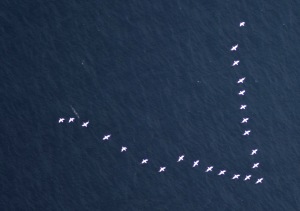In this post, Alison Johnston (@ali__johnston) talks about her paper published today “Modelling the abundance and distribution of marine birds accounting for uncertain species identification”.
Ecological surveys balance the competing goals of data quality and data quantity. We can intensively survey a small area, or cover a larger area with less detail and precision, for example in large-scale citizen science surveys. Recently there has been increasing use of passive sampling techniques, such as camera traps or bat detectors, which use technological approaches to surveying nature. These can often cover a larger area with less effort than using human surveyors. However, these technological tools may not always be able to record sufficient information to identify a species or individual. For example, a blurry camera trap photo may obscure the identity of a large mammal, or the recording of a bat call may not distinguish between two similar species. Passive sampling techniques may trade-off coverage of a larger area with a reduced data quality due to lower species identification rates.

Photographic surveys of birds in marine areas have recently gained in popularity and are an example of passive survey techniques. Planes can quickly survey a large area, creating a digital snapshot of the bird population and avoiding many of the issues of double counting that can arise from the slower boat surveys. However, these aerial photographs may not always create a good enough image to identify birds to species level, particularly in older surveys when this technique was in its infancy. For example, in our survey from 2010–2012, only 23% of photographed birds were identified to species level with any confidence.
These surveys of marine birds are often conducted to estimate population size of a species and the potential impact of wind farms. The low proportion of species identified presents a major hurdle to estimating species population sizes. So how can these digital aerial data be used to estimate the abundance of a species when the species identification is uncertain? How can you estimate the abundance of a puffin population when you have mainly recorded auks? The answer is by making an intelligent guess.

Human observers on boat surveys identify up to 95% of the birds they see. We use the proportions of different species observed on the boat surveys conducted at similar times and places, to guess the identification of observations from the aerial surveys. We produce 200 random guesses for each individual bird, taking into account the precision and the consistency in the proportions from the boat surveys. We then analyse the distribution of each species 200 times – once for each set of intelligent guesses. The population abundance is estimated by taking the middle value across all 200 estimates and the confidence intervals take account of the range of the 200 population abundance estimates.

So we use the boat survey data that has high rates of species ID to produce realistic guesses of the species in the aerial survey. For species such as gannets, which are easy to identify from aerial photographs, the 200 estimates are likely to be in a narrow range, because there are few unidentified individuals. However, for a species such as a puffin, which is much harder to identify in aerial photographs, there will be a lot of unidentified individuals and therefore the 200 population estimates are likely to cover a broader range. These confidence intervals will reflect the range of potential population sizes, and therefore take account of the uncertainty in species identification.

For the first time we have demonstrated the calculation of population estimates for individual species, with surveys which have uncertain species identification. The described approach could be used in a range of situations that do not identify species with certainty. Recordings of bats from passive acoustic detectors could be combined with other data on species proportions of bats to produce intelligent guesses about which species of bat would be most likely at a given location and time. Whenever species identification is uncertain, but other information is available on species proportions, a set of realisations can be produced and population size estimated for each realisation. Species uncertainty is therefore incorporated into the estimates of population size.
Hi, what about drones? Counting birds in awkward to reach places – mud flats , cliffs, far out on water – would be a perfect non military use for this technology!
LikeLike